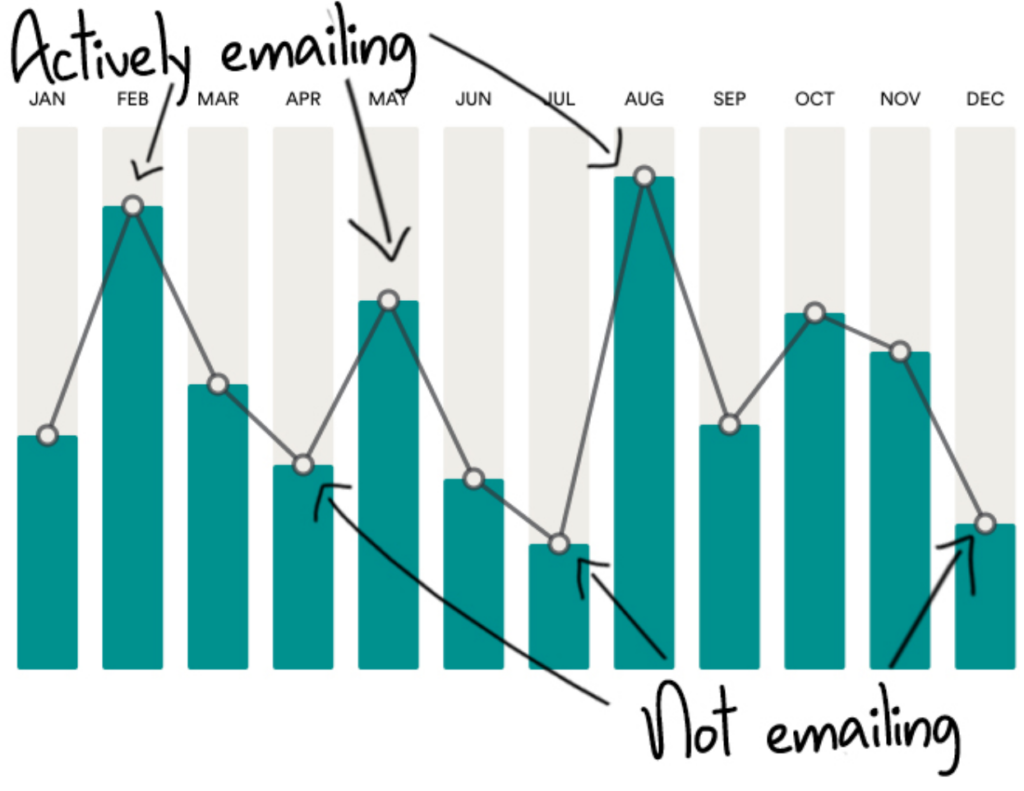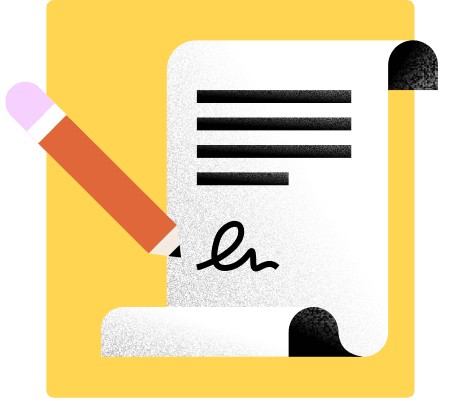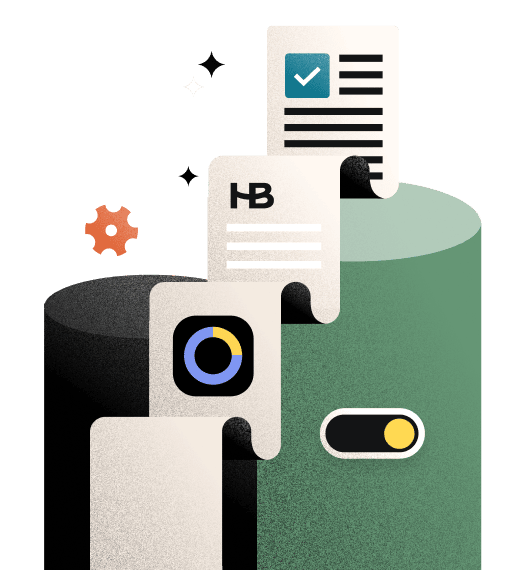Use these six tips to learn how to send cold emails that convert! Maintain a personal touch while addressing a specific pain point to guide your cold leads into becoming warm leads and paying clients.

I spent the first 8 years of my entrepreneurial journey growing my business on the side of my day job.
Working every day during my hour-long commute by train, I quickly learned that running a full-time business on a part-time schedule was no easy task.
I knew that if I ever wanted to quit my job and start working for myself full-time, I would need to learn how to reliably generate new business over and over again.
This is where learning how to send cold emails led to sustainable growth for my business. It became a reliable, relatively easy way to generate enough revenue to grow my business.
Though you might associate cold emailing with pesky sales emails, there’s a way to write effective cold emails that benefit your recipients.
Jump to:
- Does cold emailing still work?
- Figure out the right cadence for cold emailing
- Find the right person or people to contact
- Include a clear call to action
- Make every cold email highly personalized
- Keep it short and about a pain point
- Follow up like a crazy person
- Example cold email template

Simplify communication and maintain better relationships by centralizing all client interactions with HoneyBook.
Does cold emailing still work?
Cold emailing (the art of emailing a complete stranger in order to drum up business) has gotten a bad reputation over the years.
And with good reason.
Don’t you just hate it when you get a phone call during dinner to let you know that “you’ve been selected to win a 2-night stay” at some hotel you’ve never heard of?
Sleazy, unsolicited salesmanship can be just terrible.
When it comes to email, it’s even worse. Bad enough that, almost from the beginning, email providers have included a “Junk,” “Trash,” or “Spam” folder with every account.
Gmail has even gone so far as to separate out your “promotional” emails from the emails you actually want to read.
Knowing all this, it’s completely understandable you might ask: Does cold emailing even work these days?
But I’ve spoken with literally hundreds of freelancers and small business owners who swear by using cold email to attract their ideal client.
I’ve had the same experience.
Here’s some recent data from my company.
The green bars represent my company’s revenue:

You can see the months when I was actively using a cold email strategy to reach potential clients (the high points) and then you can see the months when I was busy working on projects and didn’t make time for cold outreach (low points).
What a stark contrast!
In the last few years alone, I’ve personally booked hundreds of thousands of dollars in new business all by figuring out how to send good cold emails that convert strangers into clients.
So today, I want to share a few pro-level tricks I’ve learned along the way for sending cold emails that actually convert.
By using these tips and a lot of trial and error in your own market, you can see some really great results.
Here’s my range of open rates on recent cold email campaigns.

Read on to learn how you can pursue the same success for your business using cold emails!

So we’ve compiled an email template for every type of correspondence.

1. Figure out the right cadence for cold emailing
Often-times, success in cold email outreach depends entirely on just how many emails you’re willing to send in a day or week.
My friend Jorden took her remote writing business to $5k/mo in a matter of months using cold emails.
She explains:
“You can’t just send 10 cold emails every week and expect amazing results. You need to cold email at least 20 people per day if you really want to build a clientele fast.”
I agree with her, and I’d even up the ante. If you can send more than 20 cold emails a day, do it. The more scale you can achieve early on, the more results you’ll see quickly.
If sending 20 emails a day sounds overwhelming, remember: automation is your friend. You might need to spent time up front finding contacts and writing your emails, but you can schedule automated follow-ups so you don’t need to be responding to everyone as soon as they email back.
The more emails you can send, the quicker you can learn and improve. And the sooner you’ll learn what it takes to convert clients in your industry.
2. Find the right person or people to contact
Getting high open rates (and more importantly, high response rates) depends a lot on who you’re actually sending an email to.
There was a time early in my career when I thought I could just send an email to support@[companyname.com] and ask them to connect me with the right person to talk to.
That was stupid. It was a waste of time.
Once you’ve found a company you’d like to work with, free tools like Linkedin Company Pages (click “see all employees” and then filter by job role) and the Hunter.io (which helps you guess a person’s email address) make this whole process much simpler and more effective.
When trying to determine who to email, stay away from the extremes of the totem pole.
People “at the top” are very busy and are less likely to respond to your cold email. But people “at the bottom” often have zero power to make a decision to hire you.
Instead, aim for middle management (Managers & Directors) who usually have some autonomy and budget, but also have time to check and respond to email.
It also helps to find two contacts at the same company (maybe in the same department) that you can email together.
You can make your best guess at this using Linkedin Company pages and filtering employees by their title or role.
You’ll have even more success if you can find two people with a boss/employee relationship.
You can always start your email by saying something like: “Sorry for CCing you both here, but I wasn’t sure which one of you I should email my question to.” That way, they both realize someone else is copied on the email.
Why does this work so well? Consider what you might do if you received an email and your coworker was copied on it. At a minimum, you’d talk together and decide who should respond.
Now imagine what happens if your employee is on the email. Or, better yet, if it’s your boss. All of a sudden, the email is a topic of conversation or maybe even an action item. And it’s about as far from “tossed in the trash” as you can get.
3. Include a clear call to action
Even if your product or service has a great fit for who you’re emailing, you need to make the point of your email very clear. Are you asking to set up a meeting? Are you offering a promotion that they can redeem on your website?
Just be sure you aren’t leaving it up to them. If you ask them to “check out your website” or “respond if they’re interested” it likely won’t be enough motivation for them. Everyone’s busy, and the majority of people will scan your email.
Instead, choose a clear CTA and include it in your cold email subject line. When your contacts are reading your email, the CTA and value should be obvious. Be sure to include a clearly labeled link as well to your scheduling tool, landing page, or another endpoint.
4. Make every cold email highly personalized
One of the most important tips to keep in mind is: Personalize every single cold email you send.
Always remember that you’re not the only one sending cold pitches via email. That means you have to stand out.
The more robotic and templated your email feels, the less guilty the recipient will feel for deleting it.
Above all of that, business development and sales are just way more fun when you can be yourself—instead of some faceless bot.
Here are a few simple ways to personalize each email you send:
- Always use names to open and close your email
- Start with a cold email template to make your work easier, but be sure to fill in details like why you’re interested in their business and/or something you noticed about their business
- Use conversational language or at least “email conversational.” Avoid phrases like “to whom it may concern” or other things you’d never say in real life
- Be friendly and personable – it’s okay to sign off asking how their weekend was or wish them a good week rather than just saying “Best,” or “Thank you”
- Make sure to have a professional email signature, with an email signature generator, you can create one in just seconds.
When you get an email that feels like it’s talking ‘at’ you and not ‘to’ you, it’s easy to feel offended and aggravated. And that quickly leads to the trash can.
5. Keep it short and about a pain point
Here’s one of the biggest mistakes I see people make when sending cold emails (I get dozens of cold pitches every week):
They try to close the deal with the first email. The thinking probably goes something like: “I’ve only got one shot to do this right, so I better just give them all the information and then ask for the sale.” Remember, they’ve never met you. They’ve never heard of you.
Keep your email to less than 5-6 sentences that are easy to read and simple to answer “yes” or “no” to. They should also address a clear pain point that you can solve with your CTA. Here’s an example:
Hi, Sarah.
My name is Preston and I’m a fellow blogger. After 10 years of struggling to learn WordPress (I’m sure you know what that’s like), I finally started HandyWP.com to help bloggers who hate the tech side of blogging.
I know you work in the blogging space and I would love to see if there’s some synergy to be had between our brands.
Mind if I send a few collab ideas your way?
Preston
Keep it straightforward: four to five sentences with a simple ask at the end.
The second I get an affirmative response from this email, this is a “warm” lead and I can make progress toward booking a new client.
6. Follow up like a crazy person
Let me make myself very clear here: if you fail to build a solid follow-up process into your outreach strategy, you will most likely fail.
I don’t even need to crunch the data to tell you that most people who eventually become clients don’t respond to the first email I send them.
It takes some reminding, some prodding, and some gentle nudging to get people to respond to a complete stranger.
There are two basic types of follow-up that I recommend you use (and one you should stay away from!). Here they are:
DO send a simple reminder with the original email included below and a statement like: “Hey, Sarah. I just wanted to check in and see if you got my original email. No rush, but I’d love to chat more about how we can collaborate. Thanks! Preston”
DO ask a question & refer back to your first email with something like: “Hey, Sarah. Just checking again if it would be okay for me to send a few collaboration ideas your way. What do you think?”
DON’T send a templated follow-up without threading your previous email. I’ve literally had people send me an email that just says “I’m checking to see if you received my last email.” No previous message included. No context. Nothing. Plus, it’s terribly rude to expect me to dig back through my email to find their first one. Not happening.
Example cold email template
Use this cold email template to start reaching out to potential leads today! This is a templated email specific to someone who works in business coaching. Just be sure to personalize this template and make it your own with your voice and tone:
Copy/paste template:
Cold Emailing
Subject Line: Free automation setup for your design business!
Hey [Name],
I recently saw your post on social media about putting your design business on hold for the summer, and I was wondering if you’re interested in business automation to keep your services and revenue going while you’re away.
I’m currently offering free 30-minute automation setup sessions for businesses like yours! I want to see [Business Name] thrive this summer, so I’m excited to show you how automation can help.
Just click the button below to schedule a session. I’m looking forward to hearing from you and hoping your summer prep is going great!
Have a great week,
[Email Signature]
Start where you can and build from there
Cold emailing can feel overwhelming to get started. But the nice thing is, you can start as small as you want. Of course, results will also come more slowly, but there’s nothing wrong with sending one cold email per day to test the results.
What I personally love about cold emailing is you can literally turn it up or down, on or off, like a water faucet every time you need more freelance jobs (or have too many).
It’s mostly free, very easy, and super-effective. Paired with more traditional lead generation methods, it can be a major boost to your independent business.
If cold-emailing is something you haven’t tried before (or you’ve tried with little success) now’s the time to give it another shot. You might be surprised at your results!

Capture leads, sell services, manage projects, and nurture client relationships from one platform. All that and more with HoneyBook.



